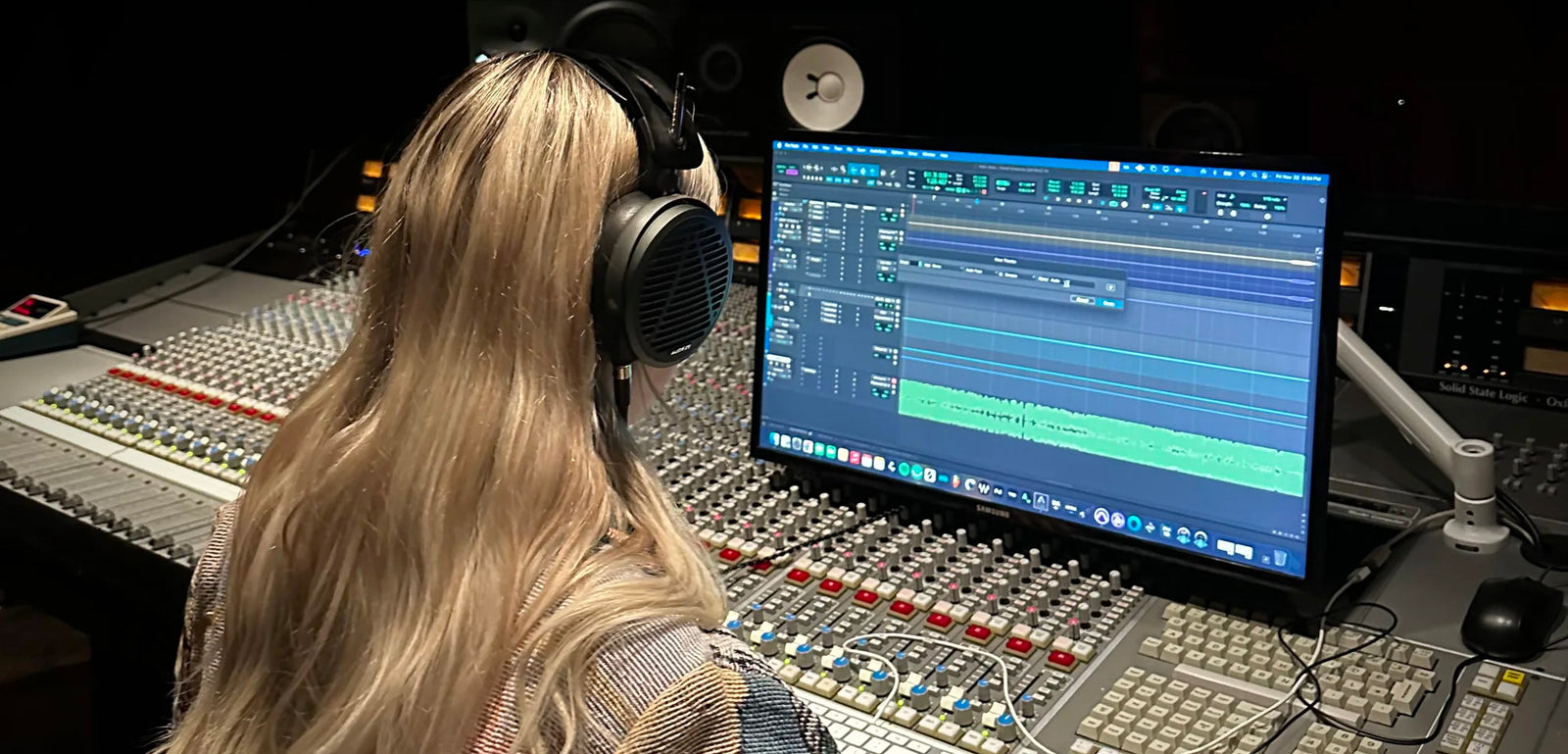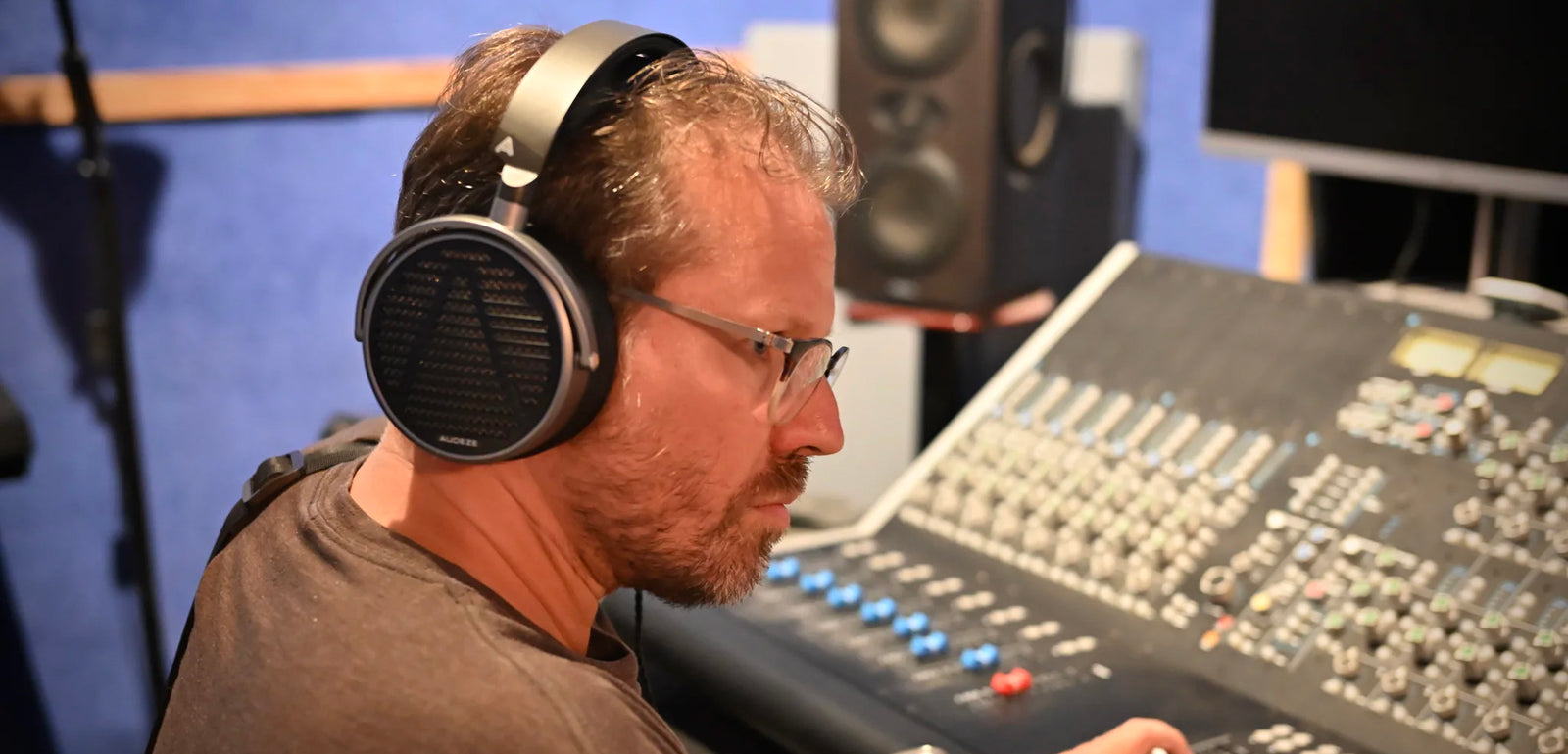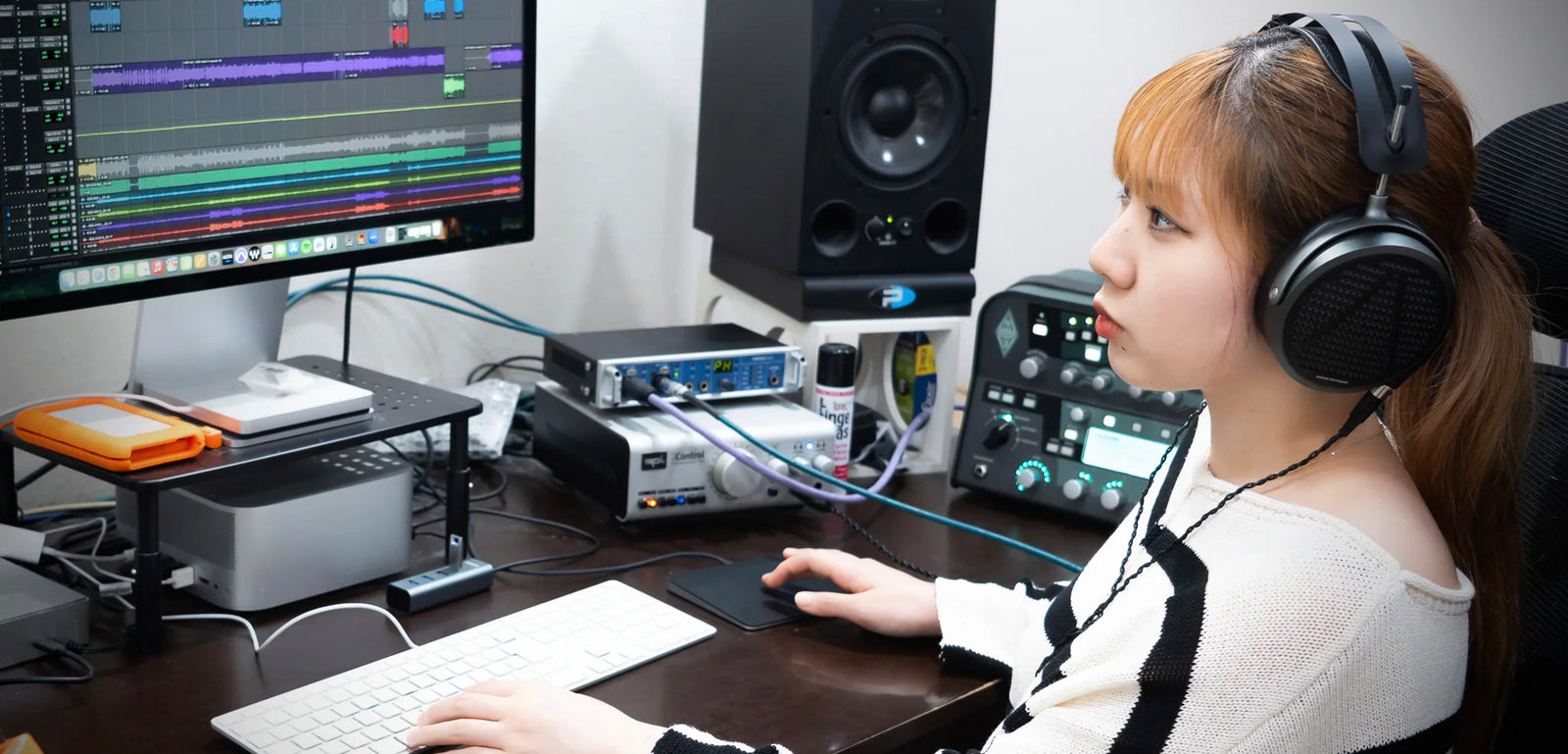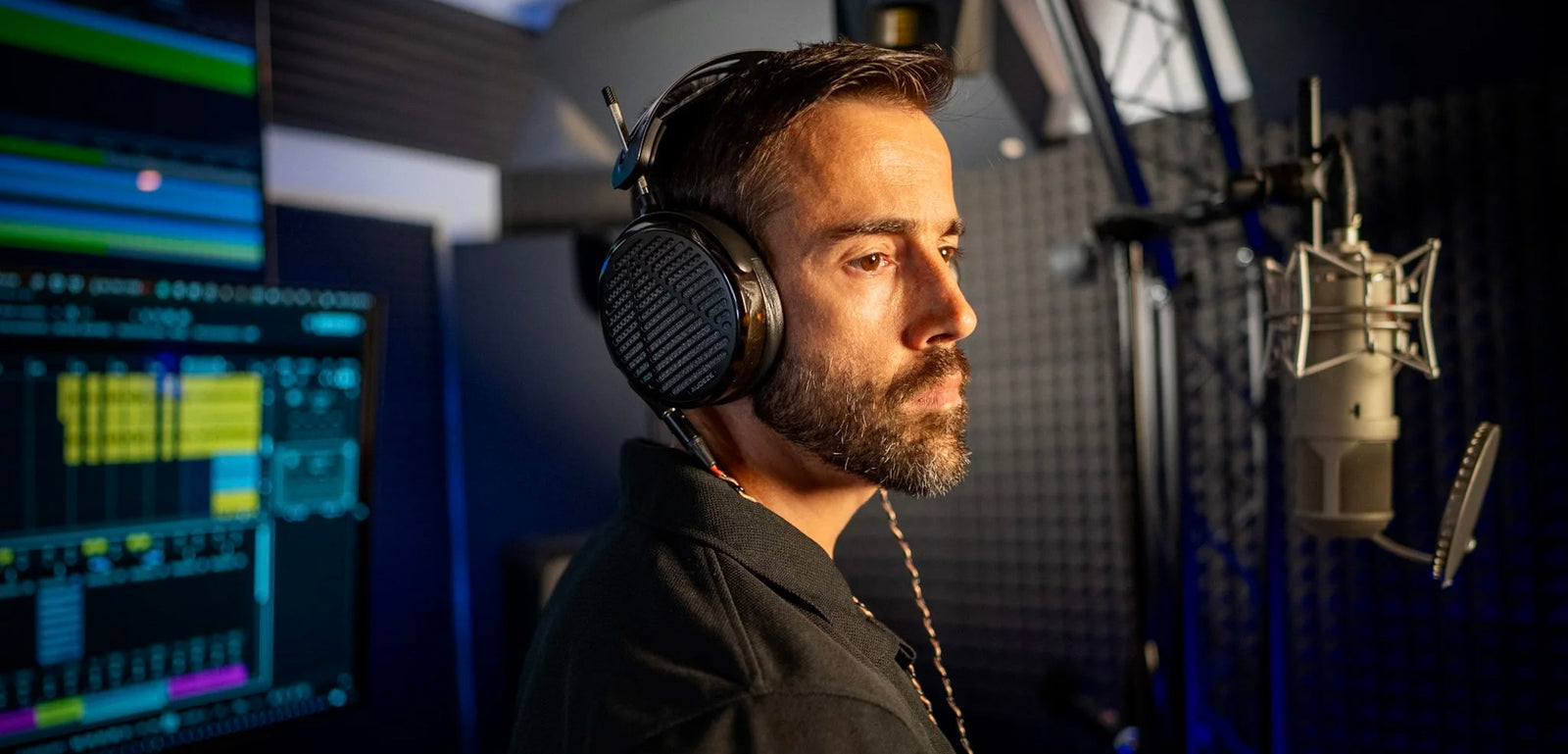
Angie Randisi is a highly acclaimed recording engineer and mixer from Canada, with three Grammy nominations and multiple platinum records to her name. Known for her technical prowess and keen ear, Angie has worked with some of the biggest names in the industry, including Lil Baby, Young Thug, Tory Lanez, 42 Dugg, Glorilla, and PartyNextDoor.

Josh Rogosin defined the tiny desk sound and has recorded and mixed over 800 shows, including Taylor Swift, Sting and Shaggy, Anderson .Paak, Mac Miller, Nile Rogers, and Bono and the Edge. His mixes have been heard on YouTube over a billion times. Now he’s introducing Global Sound and Ghost Light Concerts, traveling the world to discover how location inspires people to make music.

Li-sa-X is a Japanese female Guitarist/Composer who was born in 2005. Her cover video of RACER X's "Scarified," which she posted when she was 8 years old, garnered more than 5 million views and attracted a lot of worldwide attention. After watching this video, the composer of the song Paul Gilbert (MR. BIG) invited her to join his online guitar school as a scholarship student. She made her professional debut at the age of 12. Her playing technique has been described as “the future of rock."

Santaflow is an artist, composer, producer, entrepreneur, teacher and showman, politically incorrect and with millions of followers around the world (mainly in Spanish-speaking countries). After more than 20 years of career, he feels fitter and more eager than ever to continue creating songs and making them sound better every day. A restless lover of the world of sound, he works with several of the leading brands in the sector.
June 07, 2022
Hailed as “a fiery alto saxophonist and prolific composer” by the Star Tribune (Minneapolis), Aakash Mittal is sculpting a dynamic voice at the intersection of improvisation, composition, sonified movement, and noise. His latest album Nocturne was described as “a beautiful and challenging record” by the Denver Post (and features fellow Audeze artists Miles Okazaki and Rajna Swaminathan on their instruments, along with mixing by Liberty Ellman). As a composer, Aakash has written extensively for a variety of ensembles and mediums, generating over one hundred new works. Mittal’s awards and honors include the Chamber Music America/ASCAP Award for Adventurous Programming of Contemporary Music (2012), the Herb Albert/ASCAP Young Jazz Composers Award (2013) and the American Institute of Indian Studies Senior Creative and Performing Arts Fellowship (2013).

There is a piece on my album Videsh called “The Street” that is still one of my favorite tracks that I have made. It was my first time incorporating field recordings and found sounds into a track of acoustic improvised music. The track was inspired by my first trip to India. It was a life-changing experience where I met a bunch of my family for the first time and experienced a whole world of city sounds in New Delhi and Kolkata that I had never experienced before. On the trip, I recorded the sounds of traffic and bazaars and the environmental sounds of Indian cities. Weaving those sounds in with the acoustic improvisation of my band changed my music. I have been dealing with field recordings and noise in my music ever since.
For most of my career I have often been the band leader, composer and performer. I usually write a set of music. The band gigs and plays it a bunch. Eventually a bandmate or audience member says, “Hey, we’ve been playing/listening to these tunes for a while. You should record them.” When I get that message it usually inspires me to get in the studio and document the project. On my recent album Nocturne, it was the mridangam artist Rajna Swaminathan who, after five years of playing these tunes, said something like, “What do you think about recording this music?” That was the impetus I needed to get that process going again.
Since moving to New York, I have been doing more and more work as a composer for other musicians. I am currently working on a solo piece for violinist Mariefaith Lane and a chamber piece for Houston Symphony harpist Megan Levin. In 2019 I finished my first piece for Wind Symphony entitled “Samay Raga for Wind Ensemble”. It was performed by a consortium of eleven wind bands around the world. That was an epic project that took about four years to write. I had just moved to NYC and I didn’t have any gigs. We had one of those apartments where the studio is also the kitchen, which is also the living room. I needed a project so I just started writing the piece at the kitchen table, even though I really had no idea what I was doing. I had never written for forty instruments like that before. I remember giving the first sketch to the lead conductor and he said, “The only percussion you have is a timpani and a suspended cymbal. What would I do with the other five percussionists?” I ended up writing for eight percussionists each playing two to five instruments. There was a steep learning curve, which required it to be highly collaborative. I learned so much from writing that piece.
As a side person, I am playing in Du Yun’s band Ok Miss these days. I get to play all my instruments, like bass clarinet, saxophones, flute and so on. It’s a really great project. Du Yun has a really cool way of composing and producing the band. She gives everyone space to be themselves in the music while also having a vision for the band’s sound.
I started out playing clarinet in my school band around fifth grade. I remember budgets were low. It was a public school in the Oak Cliff neighborhood of Dallas back in the nineties. We had this real estate agent who would come in during our lunch period twice a week to rehearse us for thirty minutes. I like thinking of that story because we were all sacrificing something to be there. The kids had to give up lunch. The conductor had to come in on this break from his other job. At that time I wasn’t super into music yet. It was mostly a thing I did because my friends were doing it.
Fast forward a bit—In middle school and high school I was really into the swing dance revival that was happening in the late nineties. I used to go out dancing to live music two or three nights a week. This was in Colorado. I have to give my parents some credit for being really cool and trusting me to jump in a car with a bunch of college students to go out dancing all the time. I started exploring other dance forms like salsa and merengue. Eventually I wanted to play in a dance band and I felt at the time that clarinet wouldn’t cut it. (Of course that’s not true.) I got a saxophone and when I discovered improvisation—discovered that I could create the music in the moment—I was hooked. Playing music became an obsession.
It’s funny for me to think back on that time because the music I listen to now seems so different. Of course, it’s not completely different. I think there is still a seed of that dance music in there. I have had a long phase of listening to mostly instrumental improvised music. Lots of Black American music such as Jazz. Lots of Indian raga music. Mostly in the Hindustani tradition. Listening to New Music composers. Those communities are still a big part of my listening. Very recently all of that has been shifting again and I am starting to listen to song writers and pop artists and rap artists from various eras. In a way I feel like I am catching up with the rest of the world, lol. I just listened to a bunch of Prince on a long car ride. Some of those beats and grooves are so sick! I have also been listening more and more with an ear for track production than I used to previously. Before, I was so focused on recordings that document the sound of live acoustic performance. Now I am excited about what people are doing during the production of a track.
I feel really fortunate to have many many mentors and elders who have shared their wisdom and experience with me. Honestly, I would not be doing what I am doing without the generosity of many people. The first one that comes to mind right now is the drummer, martial artist and healer Milford Graves. I was very fortunate to have been able to work with Professor Graves over the past five years. His influence continues to deepen my creative thinking to this day. Graves’ constantly challenged the rules that I was taught and believed about music. He looked to biology and the natural environment for musical material. He would ask questions such as, “Are you playing the name of the drum or the vibrating membrane?” We are so often trained to think of music through the names of musical elements. Graves was interested in getting to the fundamentals of the sound. As I continue to decolonize my creative practice, I still ask myself if I am playing the names of the notes or the vibrating membrane.
In Kolkata, India I studied raga music with sarod artist Prattyush Banerjee. Prattyush-da gave me my foundation in Hindustani music. During that time I was also living and playing with Tanmoy Bose. At that time Tanmoy Bose was playing tabla and touring with Ravi Shankar. Tanmoy-da opened a lot of doors for me in Kolkata. There was one particular event that occurred during my time studying music in Kolkata that greatly impacted my music. One day I took a break from practicing and I went up to the rooftop of my apartment building to chill out a bit. There is a whole scene on rooftops in Kolkata. People dry their laundry on the roof. People hang out and fly kites from the roof. It’s a whole thing. I was standing on the roof listening to the city below. There was a low drone of some machinery at work. One of those sounds that you feel as much as you hear. Then I heard the rhythmic punctuation of car horns. In Kolkata drivers honk as they pass each other and often listen for each other while driving. The sound of car horns is omnipresent. There was an ambient chatter of people talking in the bazaar. The high frequency sounds of birds floated above everything else. All of the layers of the sonic spectrum were being fulfilled. I realized that the city itself was an orchestra. I was listening to the sounds of thousands of improvised decisions all within the architecture of the city. Ever since that moment I have pursued the idea of the urban noise-scape in my music. I want to write compositions that utilize the sound of people moving within the same space. I want that sound to emerge from collective improvisations within a structure.
Finishing Samay Raga for Wind Ensemble was very frustrating. It was my first time orchestrating music for about forty instruments. Most of the content was notated rather than improvised, which was somewhat new to me. I was writing for a bunch of instruments I had never written for. So musically there was a steep learning curve. On top of that I set the deadline for the project as January 1st, 2019. In my imagination I was going to finish the piece months ahead of time, so planning the delivery of the piece for January 1st was not a big deal. Come New Year’s Eve, my wife and I were having a party. Guests were beginning to arrive. I was still in the studio trying to finish the piece. It was rough. Engraving the score and parts in Sibelius was taking a long time. I had an outdated version of the software, so it kept on crashing, causing further delays. When I finally submitted the piece to the lead commissioner a few days later, I found out that the way I had organized the percussion parts was unplayable. I ended up re-orchestrating all of the percussion parts. It was a ton of work. Some days I would get up and work for sixteen hours on the piece, sleep for a few hours and do it again. While the project was a tremendous learning experience, the way I went about it made it harder than it needed to be.
I have learned to set much more realistic deadlines for myself. Even if I start a project early, it is likely that the last few weeks before the deadline will be very intense and require most of my time. This means I need to plan accordingly with my teaching schedule and family life. Additionally (and this seems like an obvious lesson) I learned that it is important to keep my software up-to-date and make sure I have the right tools for what I am trying to accomplish. At that time I had a scarcity mindset. I wouldn’t always buy the software or tools I needed because I was afraid of spending money. Finally, I discovered that I was much more critical of myself with regards to meeting the deadline than any of the conductors who had commissioned me. The piece ended up needing another six weeks of intense work past the deadline to finish. It was a humbling process. I found my collaborators to be understanding about the messiness and challenges of writing a new piece. I learned to give myself more time and more grace when working on a project.
This last year, I started using the ThinkLabs One Digital Stethoscope. It does a great job of capturing heartbeat sounds that can be recorded into a phone app or recording software. I am using the stethoscope to record my heartbeat. Then I play along with the heartbeat the way you might use a metronome. The arrhythmias and flexibility of the heart sound really helps with rhythmic feel. I also really enjoy EQing the sound in Logic [Pro X]. Milford Graves is the one who introduced me to the idea of recording and working with heartbeats. Our first lesson together was about him recording my heartbeat. The second lesson was about listening to the heartbeat and analyzing it. That experience definitely impacted my artistic practice.
My most recent instrument purchase has been a Buffet “Professional” model Bass Clarinet from the late 60s. I am so in love with this instrument. It feels and sounds like I am playing a tree--or at least what I imagine playing a tree would sound like. I have been using the bass clarinet more and more in Du Yun’s band Ok Miss, and I recently recorded it on my forthcoming album Breathe.
The gear I am using the most for creating, other than my saxophone, is my MIDI keyboard, headphones and Logic Pro X. My compositional process has changed to prioritize the sound of the music over Western notation. The MIDI keyboard allows me to work on music late at night or early in the morning when I am unable to play instruments in my apartment. It also allows me to experiment with multiple versions of a piece or part and listen back to the music right away.
I use my JBL Charge 3 portable speaker everyday for vocal riyaz (practice) and in Hindustani music workshops. It is great because I can stash it in my backpack and it projects the electronic tanpura sound very well.
I play a Selmer Series III silver plated alto saxophone. The horn was a high school graduation present that my whole family chipped in on. Now it is so tarnished and worn that people often ask if it is an antique instrument from the twenties or something. I always say, “Nope. It was super shiny in 2003.”
I want to share a thought that Milford Graves would often share with me, which is that “you have to TRUST yourself!” It’s a simple idea that can be quite profound and at times quite difficult to hold yourself to. I think trusting yourself can mean a lot of different things. Trust your vision even when it doesn’t seem to fit in the scene or industry. Trust your inspiration even if you don’t know where it is coming from. Trust what your body is telling you. Sometimes it may tell you to push forward and work harder. Sometimes it may tell you to rest and take some space from the music. That is okay too. I would also say invest in your self-care, self-love and your mental health. No joke. There can be such a romanticization of the artist that suffers and martyrs themselves for their art in our community. Challenge that idea. Taking care of yourself will only support your work.
I have been working with headphones for my entire career. This year marks twenty years of leading bands and teaching music for me. When I first started playing I would use these cheap $15 Sony headphones I could pick up at Target with an equally cheap Discman to work on transcribing the improvised solos of various saxophone players. I was using headphones all of the time. Recently, headphones have become more and more important in my composition process because I am creating the music in Logic. Rather than starting with notation, I am recording each part myself, as well as using a MIDI keyboard. I often use headphones throughout my entire composition session. I record a part. Listen back. Edit. Play again and again. Listen. Edit. Headphones have become an essential part of my creative feedback loop. They are especially helpful when dealing with biological music and listening to heartbeat recordings. It is great to have that sound right in your ears when working with heartbeats.
I am constantly amazed by the level of detail in the sound with these cans! I recently did some tracking with a new octet. The LCD-1 is already proving to be an invaluable part of the process as I listen to the session and make decisions about which take to use or ways to edit multiple takes together. This project is my first time creating a band with vocals and strings. I am able to hear the total journey of each note from articulation, to oscillation and decay in the strings. These headphones create a sonic space for the tracks that allow me to hear clarity between the vocals and instrumental parts despite the fact that they are rough takes with minimal EQ. With these cans I am able to make decisions about timbral shading and balance in a way I wasn’t able to do on my previous recordings. I think moving forward these headphones are going to allow me to produce this record with more subtleties in the tone and production than ever before.
I would also like to note that the LCD-1s are the best headphones for my aural health that I have used so far. With these headphones I can have a great listening experience and work on my projects at a low volume. I don’t find myself constantly raising the volume to try to gain more detail in the sound or to hear a specific part. I wish I had started using these headphones years ago!